 photo mag home photo mag home
 photos home photos home
OTHER REVIEWS
 Ixus 850 Ixus 850
 Nikon D80 Nikon D80
 Olympus e410 Olympus e410
 Ricoh GR Ricoh GR
 Ricoh R5 Ricoh R5
 Lumix LX1 Lumix LX1
 Fujifilm F31fd Fujifilm F31fd
 Fujifilm F11 Fujifilm F11
 Fujifilm F10 Fujifilm F10
 Olympus XA Olympus XA
 More More
 wirefresh news wirefresh news
|
 |
Olympus Evolt E-410 Review
We check out this low price digital SLR Camera.
(by Mike Slocombe for Digital Lifestyles, November 2007)
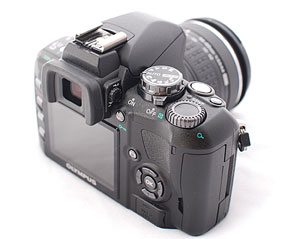 Currently the lightest and slimmest digital SLR available, the Olympus E-410 might bring a nostalgic tear to the eye of old school Olympus owners, with the camera's traditional lines evoking memories of the legendary OM series of film cameras. Currently the lightest and slimmest digital SLR available, the Olympus E-410 might bring a nostalgic tear to the eye of old school Olympus owners, with the camera's traditional lines evoking memories of the legendary OM series of film cameras.
Aimed at users looking to move up from point and shoot cameras, the Olympus comes with a raft of familiar scene modes and easy-to-navigate menus to guide hesitant newbies, but still packs enough controls to give compulsive tweakers full manual control.
In the hand
Made from a lightweight but tough plastic, the E-410 serves up a clean and concise layout with good ergonomics that feel great in the hand.
Unlike the bulky hand grips seen on most digital SLRs, the front profile of the Olympus's slim body is almost completely flat, with just a slight rubberised 'bump' to grip onto.
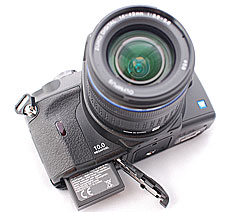 You might think that this would make it hard to keep a hold of the thing, but we actually found the E-410 very comfortable in use, and it made a pleasant change not to have to lug about a heavy beast of a camera. You might think that this would make it hard to keep a hold of the thing, but we actually found the E-410 very comfortable in use, and it made a pleasant change not to have to lug about a heavy beast of a camera.

A shufti along the top plate
The E-410s controls are logically laid out, with the shutter release falling nicely under your index finger. Behind the shutter release is a large mode dial which sits on top of the camera's on/off switch.
The mode dial offers settings for fully automatic, programmed auto, aperture priority, shutter priority and manual modes, followed by five of the more common scene modes with a general setting for accessing the additional fifteen built-in scene modes via the LCD screen.
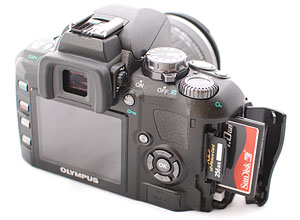 Each of these modes appears on the LCD screen with an image sample and short description, which we thought was a nice, user friendly touch. Each of these modes appears on the LCD screen with an image sample and short description, which we thought was a nice, user friendly touch.
To the right of the shutter release is an exposure compensation button, with a large flat control dial for making adjustments, like altering the f value while in aperture priority mode or changing exposure compensation levels.
On the left hand side of the camera are two more buttons - one controlling flash up/mode and the other for self-timer/drive mode, with adjustments and status displayed onscreen.
Lens Mount
Being a member of the 'Four Thirds' digital SLR family, the camera's lens mount/electronics system complies to the Four Thirds System standard, so it'll work with third party 4/3 lenses - but not, sadly, old Olympus film camera lenses (third-party adapters are available but these offering hugely reduced functionality).
Lurking inside the lens mount is Olympus's 'Supersonic Wave Filter' which dislodges any dust by vibrating a thin filter in front of the sensor at very high frequency.

Bits of gunge and thrack shaken off then drop on to a bit of sticky tape, out of harm's way. The process is automatic at start-up/shut-down and can't be disabled, but thankfully is fairly speedy.
Anyone's who spent hours delicately trying to blast lurking bits of dust off a dSLR's tiny sensor will probably find the cleaning worth the wait.
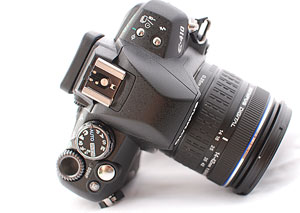
Viewfinder
The prism style viewfinder comes with a comfortable removable rubber eye cup (and dioptre adjustment) but offers a rather tunnel-like view, with the optics considerably smaller than, say, a Nikon D80. Although we moaned about the titchy viewfinder at first, in reality we soon got used to it and it was bright enough to avoid any real usability issues.
As with previous Olympus 4/3 SLRs, the viewfinder offers a centre metering circle, with three AF areas indicated by a red circle after a half-press of the shutter release.
To the right of the focusing screen can be seen a display showing metering mode, shutter speed, aperture, exposure compensation etc using rather old fashioned-looking green LEDs (in the style of the cover of The Police's 'Ghost in the Machine' but without the borked bits).
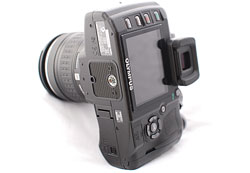 The kit lens The kit lens
Although its bathed in a sea of plastic with a feather-light weight to match (190g), the 28-84 mm equiv. f3.5-5.6 kit lens proved a great carry-anywhere choice providing a useful focal range. We weren't troubled by any undue purple fringing and the quality was easily a match for the competition.
Pop-up Flash
Boasting an electronic release mechanism, the E-410's bijou flash gun automatically pops up as required in Auto or Scene modes, and can be manually raised via a small silver button on the top plate (note that the camera has to be turned on for this to work).

The flash has a very modest guide number of 10 and an X-sync speed of 1/180 sec. The E-410 also sports an 'E System' flash hot-shoe which offers full automatic control with Olympus dedicated flash units (FL-50, FL-36, FL-20, RF-11 and TF-22), but only sync contact for accept third party units.
Without a dedicated AF assist lamp onboard, you'll soon get used to the sound of the flash unit popping up in low light.
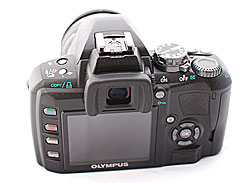
LCD Screen and a look around the back
The camera comes with a reasonable bright 2.5" 215,000 pixel LCD monitor that provides decent viewing angles. With no top plate LCD panel, all shooting parameters, preferences, menus and adjustments are carried out via the monitor, which is also used for playback and Olympus's intriguing Live View mode (see below).
Things are very much kept to the tried and trusted at the back of the E-400, with four buttons to the left of the LCD screen for viewing/deleting images and bringing up info and menus, while to the right there is a 4-way controller with central OK button.
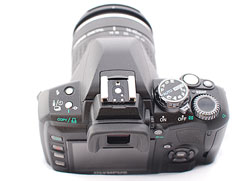 To the right of the viewfinder is an Auto Exposure/Auto Focus Lock button with a button for activating the Live View mode below. To the right of the viewfinder is an Auto Exposure/Auto Focus Lock button with a button for activating the Live View mode below.
Card slots and battery
The E-410 uses a fairly small and lightweight 1150mAh Lithium Ion battery pack which slots into the base of the camera and provides reasonable but not spectacular performance (we got around 250 shots, with a moderate amount of battery-champin' Live View usage).
Above the battery cover and incorporated into the small handgrip is the flap covering the slots for xD-Picture and Compact Flash Type II cards.
On the back of the camera is mini-USB connector providing USB 2.0 and Video Out capability (depending on which of the supplied cables is connected), protected by a rubberised cover. On the base of the camera can be found
a metal tripod socket, nicely lined up with the centre line of the lens.

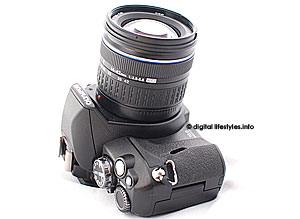
Using the camera
First off, we have to say that we loved the size of the camera. Although it's by no means pocketable, the skinny shape meant that we were more inclined to grab the E-410 instead of a digital compact, and the minimal weight meant that it wasn't a burden to shunt about all day.
Despite the camera demanding to do its supersonic sensor cleaning shuffle every time it turned on, in practice, the camera was ready more or less instantly, although not quite as fast as, say, the Nikon D40x.
The Olympus's overall performance was pretty good, with the camera focussing relatively speedily with a short shutter lag and fast buffering rates giving good continuous drive rates.
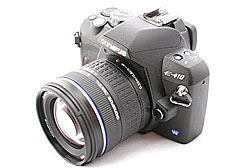 We managed to rattle off over 3 frames a second for 9 frames in RAW mode and completed a burst of 16 consecutive shots in full-size Super High Quality JPEG mode before the camera paused for breath. Impressive stuff. (Tested with a 1GB Ultra II SanDisk CF card). We managed to rattle off over 3 frames a second for 9 frames in RAW mode and completed a burst of 16 consecutive shots in full-size Super High Quality JPEG mode before the camera paused for breath. Impressive stuff. (Tested with a 1GB Ultra II SanDisk CF card).
Interface
We found the E-410's interface to be pretty much intuitive, with a clean, logical layout and well organised sub menus. Even without the manual, we rarely found ourselves stuck for long.
For exposure-meddling types, there's controls for image sharpening, contrast and colour saturation parameters, each offering five levels of adjustment.

What we didn't like was the fact that we couldn't zoom straight into a picture when shooting, or delete it without switching to the play mode first. A minor inconvenience, but one that got a bit annoying after a while.
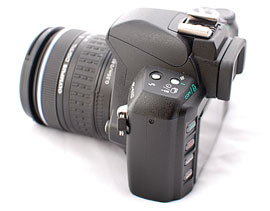 Live View Live View
One of the main attractions of the E-410 is the Live View Mode, which although remains fun and a definite improvement on its E-330 predecessor, it's still not quite as refined as it might be.
Pressing the Display button on the rear of the camera activates the live view, accompanied by a noticeable clunk as the mirror flips up. To use auto focus, the camera has to close the shutter and drop the mirror to access the AF sensor, resulting in a darkened LCD display.
Focus speeds in this mode were variable - pretty nippy in good light and sometimes painfully slow in low light (anything up to 3 seconds - and sometimes it failed to focus at all).
In manual focus, it's possible to zoom into a part of the live image up to 10x to check focus, and using Live View you get to see an exact representation of focus point and depth of field on the LCD screen, which is useful.
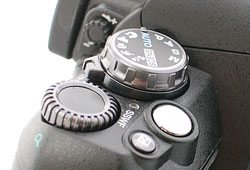 Despite its shortcomings, we grew to like the Live View Mode very much and found ourselves missing it when we returned to our usual Nikon D80. Despite its shortcomings, we grew to like the Live View Mode very much and found ourselves missing it when we returned to our usual Nikon D80.
Low light performance
Low light performance was the one thing that disappointed us about the Olympus. Cursed with no AF focus lamp, the camera is forced to pop up its wee flashgun and blast the night sly with a strobe pulse. Even with the blinding strobe bursts, the E-410 could take some time to focus, leaving the subjects feeling like they'd just survived a new interrogation technique.
And anyone looking to discretely capture wildlife scuttling around the bush at night can dream on. With the camera's intense strobing drawing comparisons with a drum'n'bass dancefloor, the only thing you're likely to attract are curious moths, confused ravers and perhaps a passing Morse Code enthusiast or two.

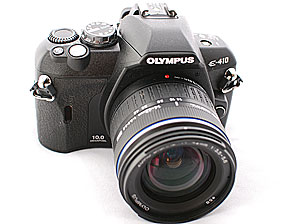
Image quality
Straight out of the box and set to auto, results were pretty good, although we found the camera had a propensity to over-expose in high contrast scenes with bright sunshine and shade (curiously, other reviewers found that the Olympus under-exposed, something we only encountered a couple of times).
Using the auto-bracketing function ensured good exposures, although we found that switching to spot metering and fiddling with the exposure compensation control gave us the results we wanted.
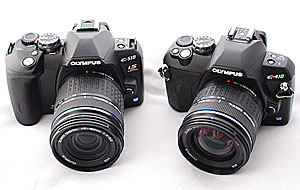 Photos were punchy, with noise levels kept low at the expense of some softness brought on by the noise filter. Turning the thing off (or setting it to low) improved things dramatically, as did turning the sharpness down to -2. Photos were punchy, with noise levels kept low at the expense of some softness brought on by the noise filter. Turning the thing off (or setting it to low) improved things dramatically, as did turning the sharpness down to -2.
As you stray into higher ISO settings you'll definitely need to reactivate the noise filter, which did a pretty good job of controlling noise right up to 800ISO.

Overall verdict
Seeing as we cut our photographic teeth with an Olympus OM10 SLR film camera before moving on to an OM2n and OM4, we were quite excited to see how a digital Olympus would shape up.
The E-410's retro shape helped whip up the nostalgia and expectations and we weren't disappointed.
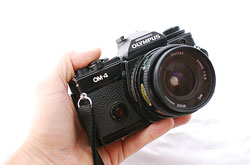 Just like its trail-blazing budget OM10 film cousin, the E-410's body design felt great in the hand and proved a great introduction to SLR photography. Just like its trail-blazing budget OM10 film cousin, the E-410's body design felt great in the hand and proved a great introduction to SLR photography.
Apart from our low light niggles, we found the camera fast, responsive and a pleasure to use.
Shutter lag was very low and with features like auto bracketing, mirror lock-up, RAW+JPEG options, Live View and the built in sensor cleaning, the E-410 represents excellent value.
With its ultra-compact size, good handling, slew of well-explained scene modes and easy-to-use interface, we could forgive the camera's rather squinty viewfinder, and have no problem recommending this as a great choice for beginners and enthusiasts on a budget.

Pros:
Great photo quality (after a bit of tweaking)
Delightfully compact and well built
Live view and dust reduction system
Loads of scene modes and manual options
RAW support
Pretty nippy performer
Cons:
xD card support - SD would be better
Some exposure issues
No AF focus lamp
Low light focussing a bit flaky
Live View still not as polished as it could be
Our verdict
Ease of use: 80%
Build: 77%
Features: 79%
Image quality: 76%
Performance (speed) 80%
Value for money: 85%
Overall: 78%

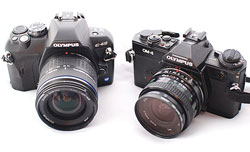 Specifications: Specifications:
Body material Plastic
Sensor 4/3 type Live MOS sensor, 10.0 million effective pixels,
RGB (Primary) colour filter array, Fixed low pass filter (anti-alias filter)
Dust suppression Supersonic Wave Filter
Image processor TruePic III
Image sizes 3648 x 2736
3200 x 2400 (3:2)
2560 x 1920
1600 x 1200
1280 x 960
1024 x 768
640 x 480
File formats RAW, RAW + JPEG, JPEG (EXIF 2.2) - (1/2.7 SHQ, 1/4 HQ, 1/8 or 1/12 SQ)
Lenses 4/3 standard lens mount (Multiply focal length by 2 for 35 mm equiv. FOV)
Auto focus 3-point TTL phase difference detection
Detection range: 0 to 19 EV (ISO 100)
Available in Live View
Focus area selection Automatic, Manual
Focus modes Single shot AF, Single shot AF + MF, Continuous AF, Manual focus
Manual focus Focus by wire
AF assist lamp Flash strobe (only

Shooting modes Auto
Program AE (with shift)
Aperture priority AE
Shutter priority AE
Manual
Portrait
Landscape
Macro
Sports
Night Scene & Portrait
Scene
Additional scene modes Beach and Snow
Candle
Children
Documents
Fireworks
High Key
Image Stabilisation Mode
Landscape
Landscape & Portrait
Low Key
Macro
Nature Macro
Night Scene
Night Scene & Portrait
Portrait
Sports
Sunset
Underwater Macro
Underwater Wide

Sensitivity
Auto (ISO 100 - 1600)
ISO 100
ISO 200
ISO 400
ISO 800
ISO 1600
Metering system 49-zone multi-pattern
Range: 1 to 20 EV (50 mm F2, ISO 100)
Metering modes Digital ESP, Centre-Weighted Average, Spot, Highlight based spot, Shadow based spot
AE Lock AE/AF lock button, With shutter release half-press
AE Bracketing 3 frames, 1/3, 1/2, 0.7 or 1.0 EV steps
Exposure steps 1/3, 1/2 or 1.0 EV
Exposure compensation. -5.0 to +5.0 EV, 1/3 EV steps
Shutter speed 60 - 1/4000 sec
White balance Auto
Overcast
Shade
Tungsten
Sunlight
Fluorescent 1
Fluorescent 2
Fluorescent 3
Manual 'one-touch'
Kelvin (3000 - 7500 K, 7 steps)
WB fine tuning Red - Blue: +/- 7 steps (2 mired each)
Green - Magenta: +/- 7 steps (2 mired each)
Colour space sRGB, Adobe RGB
Image parameters Colour mode (Natural, Vivid, Muted)
Saturation (5 levels)
Contrast (5 levels)
Sharpness (5 levels)
Monochrome (B&W, Sepia, Red, Green, Blue) - filter (Ye, Or, Re, Gr)
Gradation (High Key, Normal, Low Key)

Drive modes Single, Continuous
Continuous 3.0 fps, JPEG: Unlimited at HQ quality, RAW: 7 frames maximum
Self-timer 2 sec, 12 sec
Flash Pop-up
TTL auto / manual
Guide no. 10
1/180 sec X-sync speed
Sync modes: Auto, Red-eye reduction, Slow syncro with red-eye reduction,
Slow syncro, 2nd curtain slow syncro, Fill-in, Off
Flash power: Up to +/- 2EV in 1, 1/2, or 1/3 EV steps
External flash Hot shoe
Viewfinder Eye-level optical single-lens
Field of view 95%
Magnification 0.92x with a 50mm lens and -1 dioptre
Eye point 16 mm at -1 dioptre
Dioptre adjustment -3 to +1 dioptre
Focusing screen: Fixed type (Neo Lumi-Micron Mat Screen)
Mirror: Quick return mirror
DOF preview: press left arrow button
Viewfinder info AF frame (super impose)
AE lock
AF confirmation mark
Metering mode
Exposure mode
Shutter speed
Aperture value
White balance
Exposure compensation value indicator
Flash
Battery check
Record mode
Number of storable still pictures

Orientation sensor Yes
LCD monitor 2.5? TFT LCD monitor, 215,000 pixels, Live View available
Playback functions Single
Magnify (2 - 14x)
Index (4, 9, 16, 25 frames)
Calendar view
Rotation
Light box view
Slide show
Histogram (Lum / RGB)
Highlight & Shadow point warning
Playback information Exposure mode
Metering mode
Shutter speed
Aperture value
Exposure compensation level
ISO
Colour space
White balance mode
White balance compensation level
Focal length
Focus area
File type
Picture mode
File name
Image size
Recorded card type
Editing RAW development, JPEG editing (B&W, Sepia, Red eye reduction, Colour saturation, Resize)
Storage Compact Flash (Type I and II), xD Picture card
Connectivity USB 2.0 (Hi Speed)
Video Out (NTSC / PAL)
Power Lithium-Ion rechargeable
Dimensions 130 x 91 x 53 mm (5.1 x 3.6 x 2.1 in)
Weight (no batt) 375 g (13.2 oz), Weight (inc batt) 435 g (15.3 oz)
Price:
E-410 body only - US: $699
E-410 + 14-42 mm lens - US: $799
E-410 + 14-42 mm + 40-150 mm lenses - US: $ 899.

|